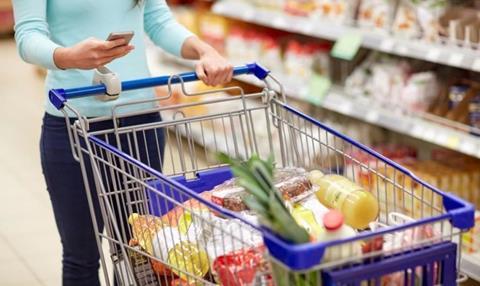As grocery price inflation hits its highest level since April 2012 at 5.2% over the latest four-week period, consumers appear to be taking action to manage the cost of grocery baskets.

The latest take-home grocery figures from Kantar show that supermarket sales fell by 6.3% over the 12 weeks to 20th March 2022, showing the impact of inflation on consumer spending. Sales are still up versus two years ago, though only by 0.7% as the comparison now includes the record buying seen before the first lockdown in March 2020.
Fraser McKevitt, head of retail and consumer insight at Kantar, said: “What we’re really starting to see is the switch from the pandemic being the dominant factor driving our shopping behaviour towards the growing impact of inflation, as the cost of living becomes the bigger issue on consumers’ minds.”
The latest data marks the first annual decline in grocery shopping trips for 12-months. Households made 15.4 visits to the supermarket on average last month, compared with 15.6 trips in March 2021.
McKevitt explained: “Higher fuel prices could be playing a role here too as people try to save fuel by visiting the supermarkets less often – something for us to keep a close eye on over the coming weeks.”
Market share breakdown
Looking at individual grocers’ performance this month, the discounters Aldi and Lidl led the pack, both boosting sales over the 12 weeks by 3.6% versus last year. This rise in sales pushed Aldi to a new record high market share of 8.6%.
Aldi was especially successful in attracting back older customers, with a 16% increase in people aged over 55 buying from the grocer. Lidl equalled the 6.4% market share high it achieved in November, also attracting back customers over the age of 55.
The only other retailer performing ahead of the market is Tesco, taking 27.4% share up from 27.1% during the same 12 weeks last year.
Sainsbury’s market share now stands at 15.1%, while Asda holds 14.5% and Morrisons 9.5%. The Co-op, Waitrose and Iceland’s shares are 6.0%, 4.8% and 2.2% respectively. Online specialist Ocado has 1.8% of the market.
Own-brand gains ground
The figures suggest that consumers are increasingly turning to own label products, which are usually cheaper than branded alternatives. Own label sales are down in line with the wider market but the proportion of spending on them versus brands has grown to 50.6%, up from 49.9% this time last year.
Grocers are also adapting their pricing strategies in response to the rising cost of goods. One trend we’re already tracking is the move away from selling products at ‘round pound’ prices. The percentage of packs sold at either £1, £2 or £3 has dropped significantly from 18.2% last year to 15.9% this March.
In March 2022, 12.6% of sales were made online compared with just 8% three years ago. Shoppers over the age of 65 are leading the charge – the proportion of this demographic buying online has doubled from 9% to 18% over the past three years.”
This story was originally published on a previous version of the Meat Management website and so there may be some missing images and formatting issues.












